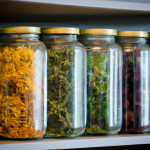“Harvest Moon: Fall Foraging to Prep for Winter!”
Fall Foraging: Prepping for Winter
As the crisp, cool days of fall settle in, nature is beckoning us to venture outdoors and discover the abundance that the season has to offer. Fall foraging not only provides an opportunity to connect with the natural world but also serves as a vital component of self-sufficiency and preparedness. By taking advantage of nature’s offerings now, we can stock up and ensure our sustenance during the long, cold winter months ahead. So, let’s dive in and explore the art of fall foraging and how to properly store the treasures we find.
1. What to Look for:
When it comes to fall foraging, there are plenty of treats awaiting us in the wild. Here are a few of the items to keep an eye out for:
- Acorns: Rich in nutrients and a sustainable source of food, acorns can be used in a variety of dishes and provide a hearty staple for winter storage.
- Mushrooms: Fall is prime mushroom season, with a wide variety of edible species popping up throughout forests and fields.
- Nuts: Hickory nuts, chestnuts, walnuts, and hazelnuts are just a few examples of the protein-rich nuts that can be harvested in the fall.
- Berries: While most berries ripen during the summer months, some, like rosehips and elderberries, can still be found in the fall and provide essential vitamins.
- Root Vegetables: Fall is the ideal time to dig up root vegetables like wild carrots, parsnips, and burdock roots, which can be stored for months.
2. How to Store Foraged Food:
Once you’ve gathered your foraged treasures, it’s crucial to properly store them to ensure their longevity and nutritional value. Here are some guidelines to follow:
- Cleaning: Thoroughly clean all foraged food to remove dirt, bugs, and any other unwanted debris.
- Drying: For items like berries and mushrooms, consider drying them to extend their shelf life. Spread them out on a clean surface in a well-ventilated area until completely dry.
- Canning and Preserving: Some fruits and vegetables can be preserved through canning, pickling, or making jams and jellies. These methods not only prolong the storage life but also add flavor.
- Freezing: For items like berries or blanched vegetables, freezing is an excellent option. Just make sure to store them in airtight containers or freezer bags to prevent freezer burn.
- Root Cellar: Root vegetables like carrots, parsnips, and potatoes can be stored in a root cellar. Ensure that the cellar has proper temperature and humidity control to prevent spoilage.
- Dehydrating: Fruits, vegetables, and herbs can be dehydrated using a dehydrator or simple air-drying methods. Store the dried items in airtight containers to extend their shelf life.
3. Ensuring Your Winter Food Supply:
By foraging and storing food during the fall, you are taking a significant step towards self-reliance and preparedness. With winter often comes harsh weather, and access to fresh produce becomes limited. By stockpiling your winter pantry with foraged food, you are ensuring a sustainable and nutritious food supply.
However, it’s important to remember that foraging should be done responsibly and with knowledge. Proper identification of edible plants and fungi is crucial to avoid any potential health risks. Consult field guides, join local foraging groups, or take a foraging course to enhance your knowledge and skills before heading out.
So, gear up, head out, and embrace the abundance of fall foraging. Mother Nature is offering her bountiful gifts; it’s up to us to seize them and create a secure and self-reliant future for ourselves.




GIPHY App Key not set. Please check settings